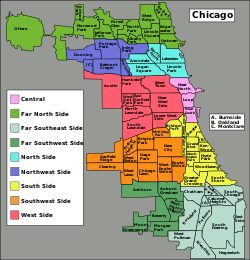Sociologist and other researchers at times specify the specific type of gentrification by using terms such as: white gentrification, black gentrification, or Latino gentrification. [12] [8] The agents of gentrification can be wealthier white residents moving in as well as wealthier black and Hispanic residents. Researchers have noted that different gentrifiers affect the ways in which local communities react to gentrification and how they see the invasion of space. [8]
Environmental gentrification
Environmental gentrification (also referred to as 'ecological gentrification' or 'green gentrification') refers to the phenomenon in which property values increase based on the cleaning up of previously polluted grounds and the implementation of public or green amenities to attract affluent white residents. [13] These efforts are often marketed as "environmental sustainability" or "urban renewal" policies. In Chicago, environmental gentrification includes not only the creation of green spaces but also the inter-mixing of low-, middle-, and upper-class residents into mixed-income housing and schooling structures. While the intention may be to lessen segregation, the result can be heightened tension within a local community.
For environmental gentrification to occur, hazardous pollution conditions must already exist. In a study from 1993 to 2013, researchers identified hot spots and cold spots of elevated blood lead levels (EBLL) across Chicago's 77 community areas. [14] Researchers found that most EBLL hot spots were located on the city's South and West Sides, while the cold spots were concentrated in the northern community areas. The presence of these EBLL hot- and cold spots correlated to the EBLL found in Chicago youth, with Fuller Park, located on the city's South Side, having the highest childhood EBLL rates in the city. [14] Additionally, EBLL in Chicago youth has decreased from 1999 to 2013, though this new, decreased percentage reflects that of the U.S. national average in 2002. [14] [15]
Similar pollution patterns can be seen in the prevalence of brownfields in certain community areas. Brownfields, or unused properties with known or suspected environmental contamination, hinder potential land use initiatives. [16] When cleaned and redeveloped, these fields can be used for housing, retail businesses, recreational areas or parks, or community buildings; thus, acquiring a No Further Remediation letter from the Illinois Environmental Protection Agency (IEPA) is needed to begin the process. [17] Brownfield cleanup and remediation efforts are paid for either by the current landowner or by the new purchaser; costs are determined, in part, by the size of the brownfield. Researchers found that black residents' willingness to pay for cleanup or remediation efforts was less than that of their white counterparts. This disparity is likely the result of income inequality between both racial demographics. [17]
Some researchers have identified the City of Chicago's (2000) Plan for Transformation of public housing (PFT) and (2004) Renaissance2010 (Ren2010) initiatives as the catalysts for a series of mixed-income strategies for poverty de-concentration, namely on the city's South Side. [18] PFT, launched under the HOPE VI program, planned to rehab large public housing complexes, dispersing their low-income residents into smaller public housing units or privately owned rental properties. Ren2010 was marketed to residents as an attempt to reform failing Chicago Public Schools (CPS) and replace them with selective-enrollment charters, most of which were or are privately owned. Both initiatives led to the creation of new mixed-income communities and paved the way for residential or commercial developments in, and the subsequent gentrification of, affected neighborhoods. [18]
Impact on residential mobility and movement
Through sustainable 'greening' efforts to clean up sites of pollution and the merging of mixed-income persons into shared residential spaces, environmental gentrification efforts bring low-income people of color and affluent white people into proximity. This can cause tensions among native and prospective residents, as the former experiences a "root shock," or a feeling of social or communal disorientation as a result of their displacement. [18]
Colloquially referred to as 'The 606,' the Bloomingdale Trail is a green space amenity located on the city's Northwest side. In 2016, 46 interviews were conducted with residents of the four surrounding neighborhoods of the Bloomingdale Trail: Wicker Park & Bucktown and Logan Square & Humboldt Park. The residential dynamics between white, adult residents, and resident youth of color under the age of 26 were analyzed. [19] In their interviews, the youth of color expressed that white residents' fear of them, as well as their subsequent labeling of youths of color's leisure activities as "deviant" was linked to white residents' hyperawareness of their minority status within the community. This awareness led to white residents going out of their way to avoid contact with the youth of color. These sentiments were echoed in the interviews with white residents, who frequently mentioned they were "scared" of the youth of color, and that, more specifically, their congregation in public spaces made them feel unsettled. [19] This friction impacted the occurrence and prevalence of citizen-based policing, or the monitoring of a community done by residents who use the non-emergency, 3-1-1 line to report perceived problematic behavior to law enforcement. [19] Youth of color reported that these efforts taken by their white neighbors made them feel alienated and un-welcomed in their own communities.


